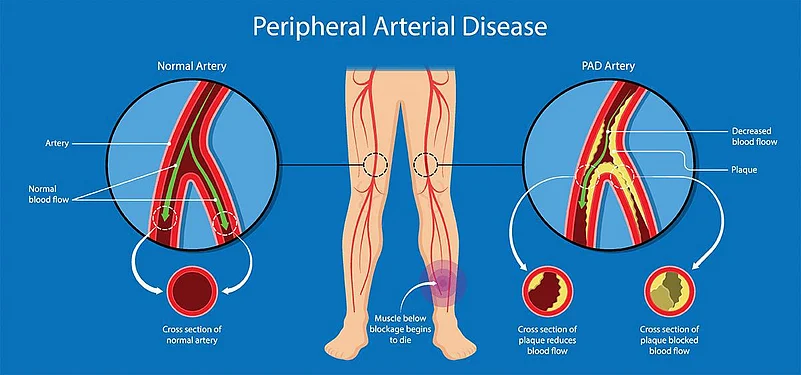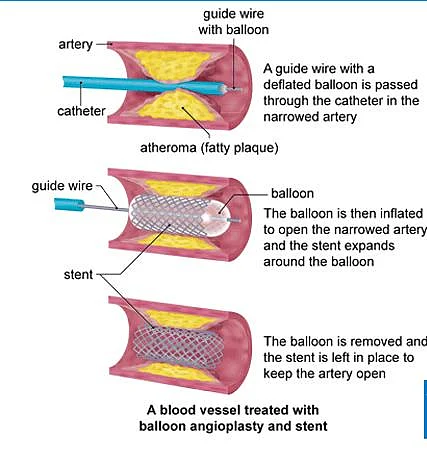A recent news article brought the buzz on the limb angioplasty of a Bollywood celebrity in Mumbai which was being searched across for more information. For the inquisitive lot, we have tried to explain the need, process, and expectations of the limb angioplasty procedure and who should get it done.
Introduction:
Angioplasty of the legs, also known as peripheral angioplasty or percutaneous transluminal angioplasty (PTA), is a minimally invasive procedure commonly performed by vascular surgeons to treat Peripheral Artery Disease (PAD) or venous diseases. The blood vessels of the extremities (arteries – carrying oxygenated blood from the heart, veins – carrying deoxygenated blood back to the heart) excluding the ones supplying the heart may get blocked acutely or chronically leading to some symptoms, as detailed below, which can be opened by minimally invasive endovascular techniques by Vascular and Endovascular specialists. In this article, we'll delve into the intricacies of angioplasty of the legs, its procedure, its benefits, and the crucial role played by vascular surgeons in its execution.
Understanding Peripheral Artery Disease (PAD):
Before delving into the specifics of angioplasty, it's essential to grasp the underlying condition it aims to treat: peripheral artery disease. This condition occurs when plaque buildup narrows or blocks the arteries due to atherosclerosis, reducing blood flow to the legs. Common risk factors for PAD include smoking, diabetes, hypertension, high cholesterol, and a sedentary lifestyle. Symptoms may include cramping leg pain (in calf, thigh, or buttocks) on walking, known as intermittent claudication or non-healing ulcers in the foot, and blackish discoloration (known as gangrene).

Venous diseases: Blood clots may develop in the main veins of lower or upper limbs leading to sudden onset of massive swelling, redness or pain which is known as deep vein thrombosis (DVT). If detected in time, and Endovascular specialist may remove/dissolve the clot alongwith ballooning or placing as stent in the vein if required.
The Role of Vascular Surgeons:
Vascular surgeons are uniquely trained specialists with expertise in managing conditions affecting the blood vessels, including PAD, and DVT. Their comprehensive training equips them to diagnose and treat a wide range of vascular disorders, employing both surgical and minimally invasive techniques. When it comes to angioplasty of the legs, vascular surgeons play a pivotal role in assessing patients, determining the most appropriate treatment strategy, and performing the procedure with precision and expertise.
The Procedure:
Angioplasty of the legs is typically performed in a specialised vascular interventional suite or catheterisation laboratory (known as Cath Lab). The procedure begins with the administration of local anaesthesia to the affected leg, ensuring patient comfort throughout the process. Using fluoroscopic guidance, the vascular surgeon inserts a catheter into the affected artery or vein, usually through a small puncture in the groin or wrist.
Once the catheter reaches the site of the blockage, a tiny balloon attached to the catheter is inflated, opening up the blockage and widening the narrowed passage. This restores blood flow to or from the affected leg, alleviating symptoms and improving overall circulation. In some cases, a stent may be placed during the procedure to help keep the artery or vein open and prevent re-narrowing.

Benefits of Angioplasty/Venoplasty:
Angioplasty of the legs offers numerous benefits for patients with PAD or venous blockage, including:
1. Improved Blood Flow: By widening the narrowed arteries or veins, angioplasty restores adequate blood flow to or from the legs, relieving symptoms such as pain/cramping/healing the wound or reducing swelling.
2. Minimally Invasive: Unlike traditional open surgery, angioplasty is minimally invasive, resulting in less pain, shorter recovery times, and reduced risk of complications.
3. Day Care Procedure: In many cases, angioplasty can be performed on a day-case basis, allowing patients to return home the same day and resume normal activities shortly thereafter.
4. High Success Rate: Angioplasty has a high success rate in restoring blood flow to the legs and improving symptoms, with most patients experiencing significant relief post-procedure.
Post-Procedure Care:
Following angioplasty of the legs, patients are typically monitored for a brief period to ensure stability before being discharged home. Patients need to follow post-procedure instructions provided by their vascular surgeon, which may include:
1. Taking prescribed medications to prevent blood clots and manage underlying conditions such as hypertension and diabetes.
2. Adopting lifestyle modifications, including smoking cessation, healthy eating, regular exercise, and weight management, to reduce the risk of disease progression.
3. Attending follow-up appointments with their vascular surgeon to monitor progress, address any concerns, and undergo periodic imaging studies to assess arterial/venous patency.
Conclusion:
Angioplasty of the legs is a highly effective treatment option for patients suffering from blood vessel blockages, offering significant improvements in symptoms and quality of life. As vascular surgeons, we are committed to providing comprehensive care for patients with vascular conditions, employing advanced techniques such as angioplasty to optimize outcomes and restore vascular health. By raising awareness and educating the public about this minimally invasive procedure, we strive to empower patients to make informed decisions about their vascular health and seek timely intervention when needed.
In closing, vascular surgeons or vascular surgery departments are available across India,
If you or a loved one are experiencing symptoms of peripheral artery disease or blocked veins of your limbs, don't hesitate to consult with a qualified vascular surgeon to explore treatment options. Your vascular health is paramount, and we are here to support you every step of the way.
From inputs by: Dr Ravul Jindal, Dr Tapish Sahu, Dr Luv Luthra, Dr Mamata SH, Dr Pravin Narkhede
Contact All India Toll-free number for any further query: 18002035156
















